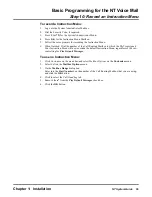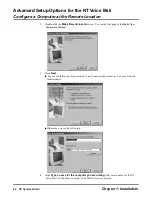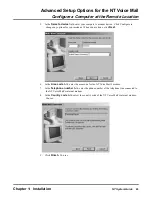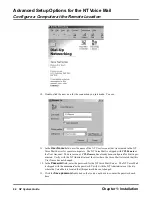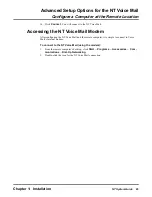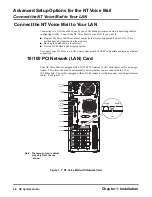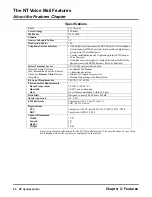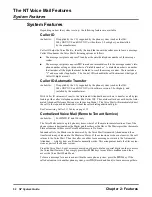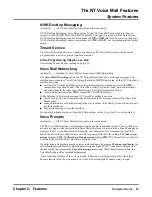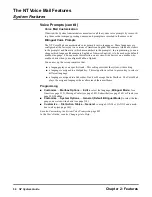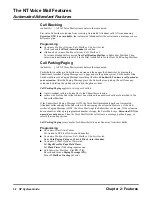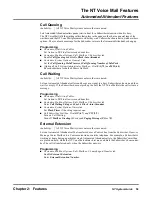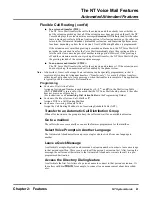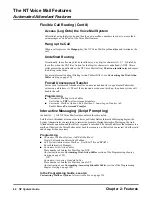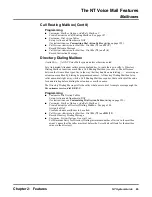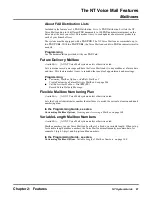
The NT Voice Mail Features
System Features
52
NT System Guide
Chapter 2: Features
System Features
Depending on how the system is set up, the following features are available:
Caller ID
Caller ID helps the Voice Mail to identify the trunk that an outside caller uses to leave a message.
Caller ID enhances the Voice Mail’s listening options as follows:
O
The message recipient can press
TI
and hear the outside telephone number of the message
sender.
O
The message recipient can press
MC
to make an immediate call to the message sender’s tele-
phone number as long as tht number is a “dialable number.” A dialable number is a number
that includes all the digits that must be dialed to reach the message sender. These include a
“1” and area code if applicable. The Central Office handlin the call determines what type of
Caller ID digits are sent.
Caller ID Automatic Transfer
With Caller ID Automatic Transfer, the Automated Attendant knows where to transfer a call by just
looking at the caller’s telephone number (the Caller ID). The outside caller does not hear the Auto-
mated Attendant Welcome Message (or Instruction Menu). The Voice Mail will immediately direct
the call to the required destination, without the caller dialing additional digits.
See Customizing Caller I.D. Tables on page 115.
Centralized Voice Mail (Remote Tenant Service)
The Voice Mail can serve up to 4 phone systems, where 3 of them are in remote locations. One of the
phone systems is designated as the Master and the others as the Slaves. The Master provides the remote
Slave extensions
with access to Voice Mail features via Tie Lines.
Inbound calls to the Master can be answered by the Voice Mail Automated Attendant and then
transferred to any extension in the Master or Slaves. If the extension user does not answer, the call
returns to the Voice Mail. Then the caller can either leave a message or return to the Automated
Attendant — which is how a call transfer normally works. This arrangement treats the Slave exten-
sions as parts of the Master system.
From the Voice Mail: Local or remote users do not have to dial any special digits in order to access
the Voice Mail features. They simply press their
MSG
keys to reach their mailboxes and then
access the Voice Mail Main Menu.
To leave a message for an extension within the same phone system, press the
MSG
key. If the
called extension is in another phone system, press
RS
(
Record and Send
)
to leave a message there.
Availability:
If supplied by the CO, supported by the phone system (such as the124i/
384i, ONYX VS and ONYX IV with sofware 3.0 or higher), and installed
by the manufacturer.
Availability:
If supplied by the CO, supported by the phone system (such as the124i/
384i, ONYX VS and ONYX IV with software version 3.0 or higher), and
installed by the manufacturer.
Availability:
For
ONYX IV
and 384i only.
Summary of Contents for NVM-NT
Page 28: ...Table of Contents Chapter 5 Maintenance xxvi NT System Guide ...
Page 130: ...Installing SMDI 102 NT System Guide Chapter 3 Programming ...
Page 146: ...Customizing Caller I D Tables General Tab 118 NT System Guide Chapter 3 Programming ...
Page 156: ...Customizing Callout Options Optional Tab 128 NT System Guide Chapter 3 Programming ...
Page 182: ...Customizing Distribution Lists General Tab 154 NT System Guide Chapter 3 Programming ...
Page 338: ...Customizing Port Options General Tab 310 NT System Guide Chapter 3 Programming ...
Page 358: ...Customizing System Options Timers Tab 330 NT System Guide Chapter 3 Programming ...
Page 362: ...Customizing System Options Timers Tab 334 NT System Guide Chapter 3 Programming ...
Page 367: ...Customizing Tenant Options General Tab Chapter 3 Programming NT System Guide 339 ...
Page 396: ...Viewing and Printing Reports System Options Report 368 NT System Guide Chapter 3 Programming ...
Page 400: ...Performing a Local Backup Backup Dialog Box 372 NT System Guide Chapter 3 Programming ...
Page 440: ...Using Port Activities 412 NT System Guide Chapter 3 Programming ...
Page 454: ...Using Message Status Message Status Dialog Box 426 NT System Guide Chapter 3 Programming ...


